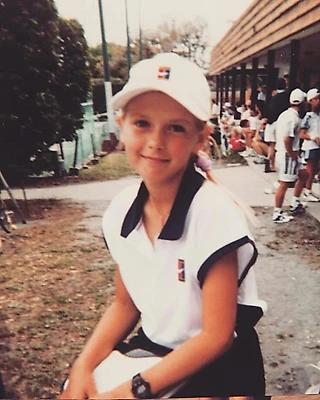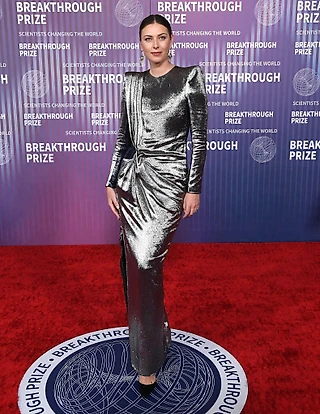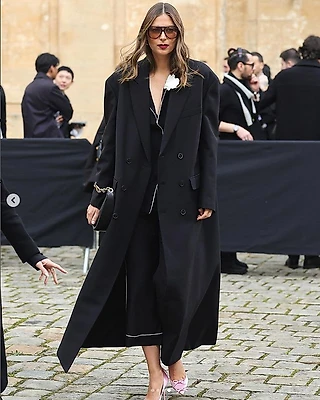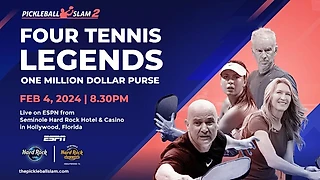Sharapova, Connors and Vincenzo Pentangeli - Eight people shaping the Maria and Jimmy business
by Joel Drucker
Maria Sharapova: CEO
Sharapova has made one of the great comebacks. At the end of 2010, Sharapova was ranked 18 in the world. While unquestionably her 2008 shoulder surgery had been a factor in her decline, it was hard to imagine Sharapova at that point reemerging as a significant Slam contender. That the medium for her resurgence would be clay was downright implausible.
But given Sharapova’s skill at hiding in plain sight, it’s a tale that will never be told with the depth and nuance it deserves. Sharapova is all business. It’s fascinating that one of the best stories ever written about Sharapova was a 2011 New York Times story about her corporate partnerships. Similar to the way Russian science fiction tales were allegories for that nation’s political environment, Sharapova’s extensive comments in that story inadvertently (?) reveal her approach to the tennis: ambition, tenacity and, in the interest of the best possible outcome, controlling as much of the process as she can.
Just don’t expect her to talk much directly about her tennis. Pluming the craft – inside the lines, practice sessions, tactics, strokes and the lessons gained from wins and losses – is a whole other matter. The tennis is, as her new coach Jimmy Connors once called it, “my own personal business.”
Ivan Lendl: Model
Wait a sec, what the heck is he doing here? Lendl represents a distinct coaching model for Connors. Call it the uber-champion as coach. Though not new – Billie Jean King aided Martina Navratilova – the uber-champion operates in a way different than is often seen in pro tennis.
Most coaches need the job, serving at the behest of the player; quite different from team sports where the players report to the coach. The employer-employee nature of tennis player and coach demands a certain kind of persuasive engagement on the part of the coach. According to ex-pro and psychologist Allen Fox, “Ultimately the coach has to have power, and that’s not so simple given that the coach is at the behest of the player. But the great player brings a bigger level of credibility. It also helps that he probably doesn’t need the money.”
Go take charge of the match and use that forehand, Lendl has likely told Murray. He likely knew this before he ever met Lendl, but hearing it from an eight-time Slam champion with a dictatorial forehand added even more heft.
Then there was the matter of Murray’s emotional woes, the negative energy that would erode his confidence in Grand Slam finals. Go whine to your mommy, said Lendl. Start whining around me and all you will get is a death stare. Don’t even think I need this gig, for I have won far more than you. But yes, I will continue to believe in you so long as you fulfill our agreement.
Here, the model for Connors of the uber-player as tangible presence. Ethereal? Perhaps, but picture yourself as a financial planner. Imagine Warren Buffett sitting nearby, engaged in your practice. The ethereal can prove motivational.
Serena Williams: Problem
Murray’s issue was emotional negativity. Sharapova’s problem is, alas, far less controllable, coming in human form in the person of Serena Williams. Sharapova can problem-solve anyone else in tennis. That’s not to say she will always beat Victoria Azarenka, Agnieszka Radwanska, Petra Kvitova or other top players. But versus anyone but Serena, Sharapova knows she can will herself into the battle, compete hard and likely win.
But Williams is a difficult matchup. Williams is faster, serves better and can match Sharapova from the ground. It might also frustrate Sharapova to know that while her supreme self-belief can often tip the scales in her favor versus all others, in that department too Serena is at least her equal.
One thing a player always needs from a coach is engaging language. That might well be even more true at the very highest levels of the game. Paul Annacone, coach to such titans as Pete Sampras and Roger Federer, told me years ago that, “when you’re that high up the rankings it’s about figuring out how to maximize your offense.” For the coach, it’s a matter of finding the right words, ideas and concepts that trigger success. Perhaps Thomas Hogstedt’s language had grown too familiar. Perhaps.
Gloria Connors: Nucleus
In the early ‘70s, at a time when tennis was still perceived as an understated garden party, Connors turned it into an electric carnival. It would be interesting to know how much Sharapova knows about her coach’s early years.
But surely she is drawn to the visceral, impassioned spirit Connors brought to competition, a foundation laid by his mother Gloria. A player good enough to play the US Championships at Forest Hills, Gloria was brilliant at explaining the binary, zero-sum nature of tennis, that the game was at heart a form of real estate conservation and, even more, personal preservation. Go after every ball. Kill or be killed. Smother them with footwork. Don’t back off. Bring out your tiger juices.
Will Connors employ Gloria’s exact words? Questionable. But surely he will channel Gloria’s concepts.
Pancho Segura: Sage
While Gloria was Connors’ undergraduate guru, Pancho Segura helped him earn a doctorate. The court was Segura’s classroom, the cocktail napkin his chalkboard for numerous diagrams on how to build points wisely. Might Connors place a call or two to his former dissertation advisor? Says Segura, “Sharapova doesn’t need to hit that hard all the time. She could come in on her return more. Or she could sneak in and volley. She’s got to get in a higher percentage of first serves.”
Jimmy Connors: Presence
Since the end of his playing days, Connors has intermittently searched to create a role for himself in tennis – forays into TV, an 18-month coaching gig with Andy Roddick and as we’ve since learned, time with Sharapova prior to the ’08 Australian Open (a tournament she won with some of the best movement, court management and ball-striking of her career).
Most of all, though, Connors has been Citizen Connors, self-exiled, living a comfortable life in the Santa Barbara area. But man does not live by golf alone. Scratch any ex-athlete deeply enough and you’ll often uncover a restless soul. No one ever associated Connors with passivity. He’s now 60, likely looking for, as they say in his beloved Las Vegas, one big final score, one more piece of action that will keep him relevant and, yes, visible.
Given the motivation, skill and success of a Sharapova, what will Connors actually bring her? It’s hard to imagine him adding technical dimensions to her game. At this stage of her career, Sharapova will likely not be adding a slice backhand or an increased use of the serve-volley.
It will be fascinating to see how Connors engages with Sharapova. With Roddick he did not travel to all tournaments. Lendl doesn’t go to all Murray’s events. But ever since she stopped working with Robert Lansdorp in 2005,Sharapova’s coach has been with her week in and week out. Will Connors? What will he say to her on those televised coaching breaks? Will he talk publicly following her matches –win or lose? Or will he assume the qualities of a sphinx?
But again, like Lendl with Murray, the potential is there to provide a presence.Connors was fond of saying he never changed his game no matter who he was playing. Surely that’s catnip for the resolute Russian. But Connors also loved to say, “there’s a game within a game within a game.” Cryptic as that might sound, if you look past the bravado and bluster of a Connors match you will see a number of subtle shifts in tactics, tempo, timing. Perhaps, just perhaps, some of those notions will seep into Sharapova’s head as she manages her way through matches – not just versus the problematic Serena but versus all opponents. “I guarantee you this,” says Segura. “Jimbo will improve her knowledge of the game.”
Werner Heisenberg: Observer
No, this is not a German Davis Cup player from the pre-Becker era. Werner Heisenberg was a physicist who coined a term known as “The Uncertainty Principle.”One major aspect of Heisenberg’s concept addresses the way objects change when placed under observation.
Such will happen now with Sharapova. We will seek to spot tell-tale signs of the Connors influence. More emotion? Taking the ball earlier? Striking more boldly? Technical shifts on certain strokes? Better footwork? All of these, for example, were questions asked constantly about Connors’ impact on Roddick.
Butseriously, will we really know or is it our desire to see these changes thatwill fuel the story? It would take significant evaluation ofmatches before and after she started working with Connors to truly determinethe scope of any of Sharapova’s improvements.
Rest assured that the non-scientific study will commence at Sharapova’s first match under Connors’ eye.
Vincenzo Pentangeli: Reminder
In the movie The Godfather II, for a number of reasons a mobster named Frank Pentangeli has chosen to testify to a Senate committee and officially implicate the man he once reported to, Michael Corleone. Pentangeli’s testimony could likely topple the Corleone regime and send Michael to jail. With Pentangeli under close watch, killing him is impossible.
But then, on the day of his appearance, Frank looks across the room and spots a man he hasn’t seen in decades. It’s his brother, Vincenzo, brought in by Michael from their ancestral homeland,Sicily. This was the place the Omerta, the code linking family and loyalty, had been formed. Vincenzo’s mere presence reminded Frank of what the two had agreed to at a prior time. Vincenzo said not a word. Neither did Frank, who instead recanted his prior statements.
This is how it will go with Connors and Sharapova. Over practices, before and after matches, at meals and over the phone, they will form their own Omerta, an approach and understanding of the tennis that will be theirs and theirs alone. A point will come when Connors and Sharapova needn’t exchange a word. As it was with Vincenzo and Frank, the message will be implicit. Just business.










Может быть кто-то переведет, буду очень благодарный
Осталось голосов 186